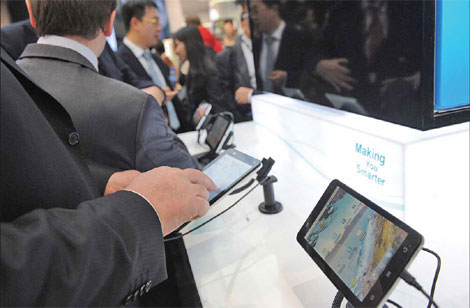ZTE banks on innovation to expand global presence
Updated: 2011-05-13 10:30
By Hu Haiyan (China Daily European Weekly)
 |
|
A visitor tests a ZTE tablet device at the Mobile World Congress 2011 in Barcelona, Spain, on Feb 15. The telecom equipment maker expects 60 percent of its sales to come from overseas transactions. Denis Doyle / Bloomberg |
ZTE Corp, the second-largest telecom equipment maker on the mainland, has announced plans to increase its presence in international markets, the latest in a wave of Chinese high-tech companies aiming to expand globally.
"US and European markets are of the greatest importance for ZTE's overseas expansion, where per capita consumption is much higher than that of the mainland and the potential is great," says Dai Shu, director of corporate branding and communications of ZTE.
ZTE, the world's fourth-largest mobile phone vendor, is a relative latecomer to the global market and competes with Huawei Technologies Co, Ericsson and Nokia Siemens Networks.
But buoyed by its estimated revenue of 140 billion yuan (14.9 billion euros) for this year, it is setting its sights high. Dai says the company wants 60 percent of its sales to come from overseas transactions.
Last year, ZTE's revenue from its international operations grew 27.45 percent to about 38.1 billion yuan and accounted for 54.2 percent of total operating revenue. And for the first time in company history, the largest portion of its overseas revenue came from the US and Europe. ZTE's year-on-year growth in the two markets was 50 percent, company officials say. That is 21 percent of its total operating revenue.
According to company figures, sales revenue in the US reached $300 million (208 million euros) in 2010, tripling the total in 2009. Sales in the US are expected to reach $600 million in 2011 and $1 billion in 2012.
Other Chinese telecom companies have also announced their intentions of boosting their international profiles. Huawei, as well as Beijing-based Datang Telecom Technology Co Ltd, said that in the past few months they will expand their overseas markets. China Telecom Corp Ltd said in March it is expanding into Canada with a subsidiary.
But there have been hurdles for these companies. Huawei's overseas expansion plans have hit roadblocks on suspicions that the company maintains links with China's military.
The US government recently asked Huawei to sell assets it bought from 3Leaf, a small US firm. Three years ago, Huawei dropped a bid to invest in 3Com under similar pressures.
Dai says that it is normal for foreign governments to have security concerns.
"To deal with this situation, first, we should be quite familiar with the rules, and most importantly, we should be innovative, transparent in business management and reasonably priced, to show them that we are a trustworthy partner," he says.
 |
|
An employee works on a communications equipment assembly line at the ZTE factory in Shenzhen, Guangdong province. Qilai Shen / Bloomberg |
"It is a long-term process to gain the trust of foreign operators and governments," he adds.
Dai says it has been difficult to tap into the US telecom market. But he also says that Americans are often straightforward and have a strong sense of principle, which could expedite future transactions.
Shi Lirong, CEO of ZTE, says that ZTE's advantages are its innovative and adaptive abilities to a changing market as well as cheaper labor in China.
"The telecom market changes very fast. ZTE is much younger than Western telecom vendors such as Ericsson, but we are quick learners," Shi says.
In 2010, ZTE made substantial achievements in innovation to compete with its Western competitors.
In early 2011, ZTE was ranked second by the World Intellectual Property Organization with 1,863 international patent applications. ZTE has 7 percent of the fourth-generation long-term evolution (LTE) technology patents.
ZTE sued Huawei last month over alleged infringement of ZTE's LTE patents.
Dai says that in plans to expand overseas, "innovation is essential. It is no exaggeration to say that no innovation, no overseas market".
Lu Jinyong, director of China Research Center for Foreign Investment with the University of International Business and Economics, says: "With the development of China's telecom industry, it is natural for Chinese companies to go global. ZTE and Huawei's overseas expansion is just the reflection of this trend."
Lu advises companies who are aiming to expand overseas to become familiar with a region's locality, politics, cultures, environment as well as laws and regulations.
"The process of internationalization is also kind of like localization. The more you know about the local environment, the better you do business with the local partners. Especially since the telecoms industry is quite 'sensitive', causing security concerns for the governments, it requires more communication and efforts for telecom companies to step into overseas market," Lu says.
Dai says the biggest challenge for ZTE in its overseas ambitions lies in its expansion strategy.
"For some markets, you cannot gain profits, even suffer losses, when you first step into that market, and you should decide whether it is worthwhile for you to insist in the market," Dai says.
"Take the US market, for instance. Once, we cooperated with a local operator to develop a technology. But for some reason, the operator broke off contact and we suffered huge losses. But for us, the US market is of vital importance. We should insist in tapping it no matter how big the difficulties are."
Dai also says ZTE wants to establish long-term partnerships with countries, which will involve employing people in local markets and developing technology to suit local requirements.
ZTE was established in 1985 in Shenzhen, South China's Guangdong province, as a jointly owned electronics firm with only 2.8 million yuan in capital.
In 1995, ZTE took its first steps toward globalization when it established branches in Indonesia. It now has 107 offices and subsidiaries in more than 100 countries across the world, providing services to more than 500 operators from 140 countries and regions and employing more than 85,232 people.
E-paper

Green works
Wuxi becomes 'test case' for facing country's environmental challenges
Preview of the coming issue
The global rise of Chinese brands
China-EU trade on solid ground
Specials

The song dynasty
There are MORE THAN 300 types of Chinese operas but two POPULAR varieties are major standouts

Cut above the rest
One of the world's oldest surgeons has performed more than 14,000 operations

From the ground up
Architect of Guangzhou Opera House has many projects under way, including 2012 Olympics.
